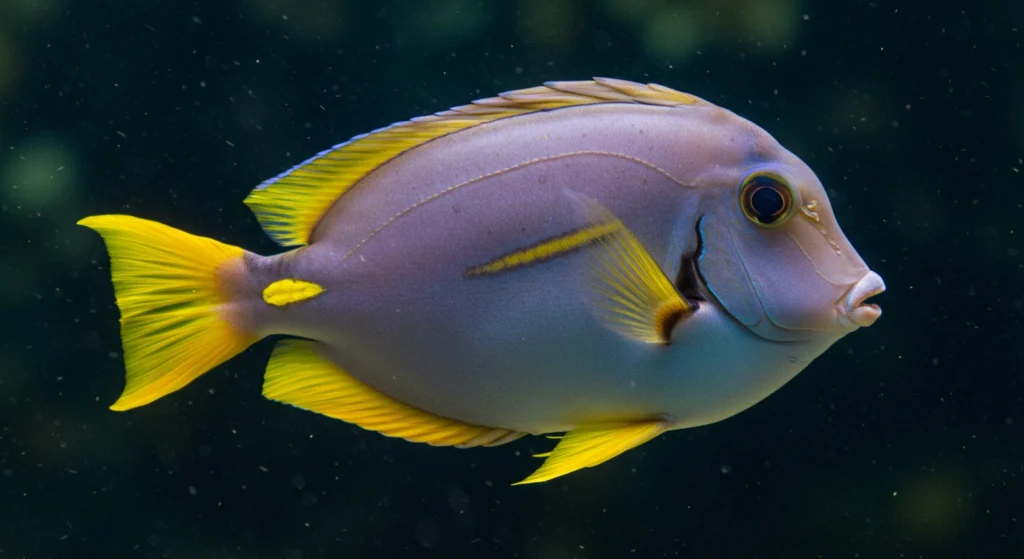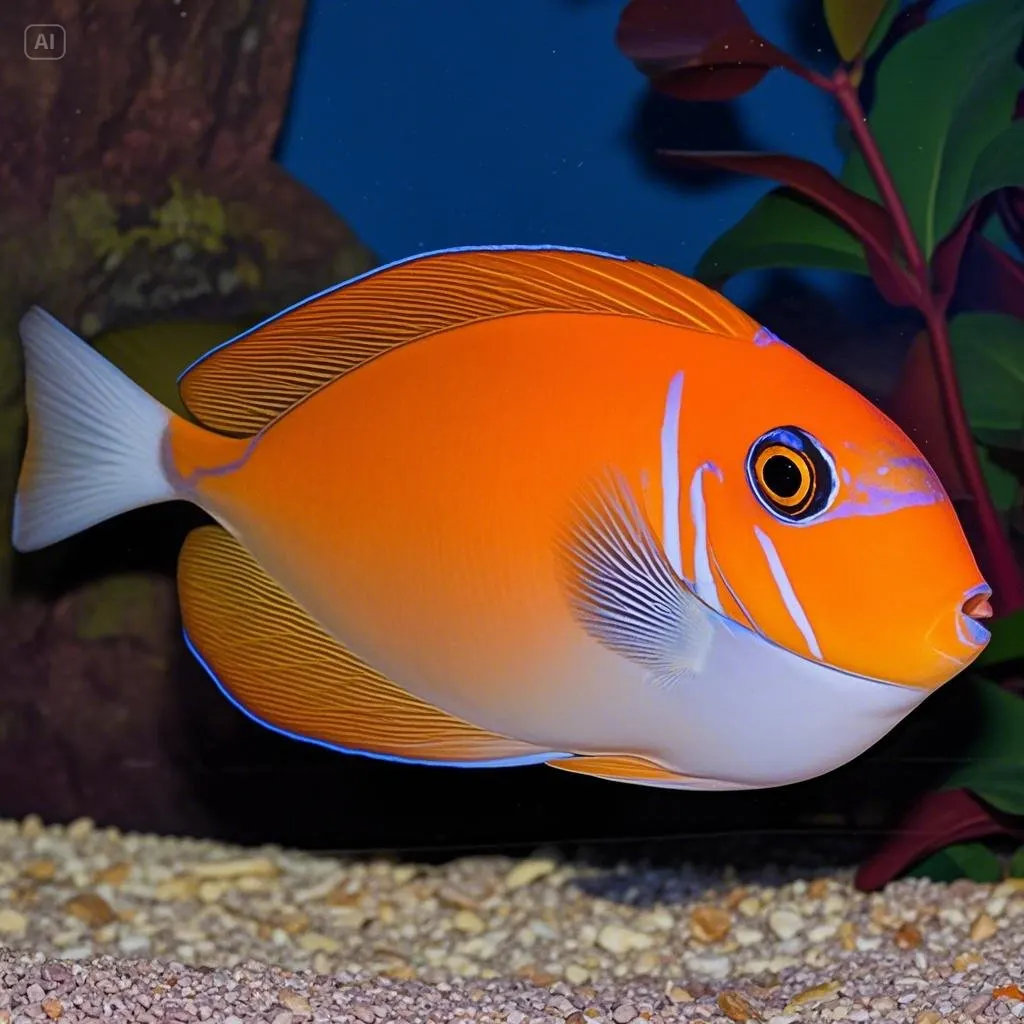Table of Contents
Introduction to the Vibrant Tang Family
Tang fish, scientifically known as members of the Acanthuridae family, are among the most visually striking and sought-after marine species in the aquarium hobby today. These colorful fish, also commonly referred to as surgeonfish, have captured the hearts of marine enthusiasts worldwide with their distinctive appearances and fascinating behaviors. Characterized by their laterally compressed, oval-shaped bodies and vibrant coloration patterns, tang fish bring a remarkable splash of color and activity to any reef environment they inhabit.
Native to tropical and subtropical waters, primarily in the Indo-Pacific region, tang fish have evolved to thrive in coral reef ecosystems. Their presence in these delicate environments is not merely aesthetic but serves crucial ecological functions. As predominantly herbivorous species, tang fish play an integral role in maintaining the balance of reef systems by controlling algae growth that might otherwise overwhelm corals and other invertebrates.
In this comprehensive exploration, we will delve into the diverse world of tang fish, examining their unique characteristics, behavioral patterns, dietary requirements, and suitability for home aquariums. Whether you are an experienced marine aquarist or simply fascinated by these remarkable creatures, understanding the complexities of tang fish will deepen your appreciation for these oceanic jewels.

What Kind of Fish is a Tang?
Tang fish are marine ray-finned fish belonging to the Acanthuridae family, which encompasses approximately 86 species across six genera. These fish are most commonly known as surgeonfish, deriving this name from the distinctive scalpel-like modified scales or “surgical tools” located on their caudal peduncle (the narrow part of the body before the tail fin). These specialized structures, which vary in size and shape among different tang species, serve as defensive mechanisms against predators and can be remarkably sharp.
Taxonomically, tang fish are classified within the order Perciformes, making them distant relatives of perch, groupers, and snappers. However, their evolutionary path has led to highly specialized adaptations that set them apart from other perciform fishes. Their body structure is typically oval and laterally compressed—a shape that allows for exceptional maneuverability among coral formations and facilitates quick escapes from potential threats.
A defining characteristic of tang fish is their continuous dorsal fin, which runs along much of their body length. Their mouths are notably small and contain specialized dentition adapted for their primarily herbivorous diet. These teeth are designed for scraping algae from hard surfaces, a feeding behavior frequently observed in both wild and captive specimens.
The diverse coloration patterns exhibited by tang fish species are not merely aesthetic features but serve important biological functions. These vibrant hues can assist in species recognition, territorial displays, mating rituals, and in some cases, provide camouflage against specific reef backgrounds. Juvenile tang fish often display coloration patterns distinct from their adult counterparts, which can sometimes lead to misidentification among inexperienced observers.

Tang Fish Varieties
The diversity within the Tang fish family is truly remarkable, with each species exhibiting unique characteristics that make them special additions to marine environments. Here are some of the most popular and noteworthy tang varieties:
Yellow Tang
The Yellow Tang (Zebrasoma flavescens) is perhaps the tang family’s most iconic and recognizable member. Native to the Hawaiian Islands and portions of the central Pacific, these fish display a brilliant, uniform yellow coloration that makes them instant focal points in any aquarium. Their disk-shaped bodies, combined with their vivid coloration, create a striking visual effect as they navigate through coral formations.
Yellow tangs typically grow to approximately 8 inches in length and can live for 10-30 years under optimal conditions. Their popularity in the aquarium trade has led to significant wild collection, though recent advances in aquaculture have begun to provide more sustainable sources for this beloved species.
Blue Tang Fish
The Blue Tang (Paracanthurus hepatus), also known as the Palette Surgeonfish or Regal Tang, gained worldwide recognition through popular animated films. These stunning fish display a vibrant royal blue body complemented by black markings and a yellow tail. Native to coral reefs throughout the Indo-Pacific region, blue tangs can grow to approximately 12 inches in length and require spacious aquarium environments to thrive.
Blue tangs are particularly sensitive to water quality issues and require established aquarium systems with stable parameters. Their striking appearance makes them highly sought after, but potential keepers should be aware of their specialized care requirements and the significant space needs of adult specimens.

Black Tang Fish
The Black Tang (Zebrasoma rostratum), sometimes called the Black Longnose Surgeonfish, presents a dramatic contrast to its more colorful relatives. With a predominantly black body occasionally showing subtle blue highlights, these tangs bring an element of sophistication and contrast to reef aquariums. Native to the central and western Pacific Ocean, including areas around Tahiti and the Cook Islands, black tangs are somewhat rare in the hobby and consequently command premium prices.
Their distinctive extended snout allows them to probe into small crevices for algae and other food sources. Growing to approximately 10 inches in length, black tangs require similar care conditions to other Zebrasoma species but are generally considered more challenging due to their relative rarity and specific feeding preferences.
Purple Tang Fish
The Purple Tang (Zebrasoma xanthurum) represents one of the most prized members of the tang family. Distinguished by its vibrant purple body accented with yellow highlights on the tail section, these fish originate from the Red Sea and Arabian Sea regions. Their relatively limited natural distribution contributes to their higher price point in the aquarium trade.
Purple tangs typically reach 8-10 inches in length and display the compressed, disk-like body shape characteristic of the Zebrasoma genus. They are particularly known for their active swimming behavior and can demonstrate territorial tendencies toward similar-looking fish. Their intense coloration tends to deepen as they mature, making adult specimens particularly impressive centerpiece fish.
Orange Tang Fish
The Orange Tang, more commonly known as the Shoulder Tang or Orangeshoulder Surgeonfish (Acanthurus olivaceus), features a distinctive orange shoulder patch that gradually transitions into a bluish-gray body. Juvenile specimens display a strikingly different appearance with blue and yellow rings on a darker background.
Native to the Indo-Pacific region, these tangs can grow quite large, reaching up to 14 inches in length. Their size makes them suitable only for very large home aquariums or public exhibits. Their dietary needs focus heavily on marine algae, and they play important roles in coral reef ecosystems by controlling algae populations.
Blue Tang Fish and Clownfish
The pairing of Blue Tang fish and Clownfish in aquarium settings has become increasingly popular, partly due to their complementary visual appeal and also their iconic status in popular culture. This combination recreates a natural reef dynamic that many enthusiasts find appealing, as both species can be found in similar Indo-Pacific reef environments.
While blue tangs and clownfish can coexist successfully in appropriately sized systems, their care requirements differ in important ways. Clownfish are generally considered more adaptable and better suited to captive environments, even thriving in smaller aquarium systems. Blue tangs, conversely, require much larger aquariums (minimum 100-125 gallons for a single specimen) and more stable water parameters.
When housing these species together, aquarists must be mindful of the blue tang’s potential territorial behavior, particularly as they mature. Providing ample swimming space, adequate hiding places, and ensuring proper nutrition for both species are essential considerations. The different feeding strategies of these fish—clownfish being omnivorous opportunists while blue tangs focus primarily on algae—can actually complement each other in a well-designed system.
For successful cohabitation, introducing the more aggressive blue tang after the clownfish have established themselves in the aquarium is generally recommended. This approach can reduce territorial conflicts and allow both species to adapt more comfortably to their shared environment.
Are Tang Fish Edible?
Tang fish are indeed edible and consumed in various coastal communities throughout their native ranges, particularly in Pacific Island nations and parts of Southeast Asia. However, their status as food fish varies considerably depending on local traditions, availability of alternative seafood sources, and cultural preferences.
In Hawaii, for instance, the yellow tang (known locally as “lau’īpala”) has historically been consumed, though it is now more valued for its ecological role and tourism appeal than as a food source. Other tang species are included in traditional dishes in parts of the Philippines, Indonesia, and various Pacific islands.
It’s important to note that consuming tang fish does carry some potential health considerations. Like many reef fish, certain tang species may accumulate ciguatoxins—naturally occurring toxins produced by dinoflagellate algae that can cause ciguatera fish poisoning when consumed. The risk varies by region and specific tang species, with larger, older specimens generally presenting greater potential for toxin accumulation.
From a conservation perspective, consuming tang fish is generally discouraged in most regions due to their vital ecological role in maintaining healthy reef systems. Their value as algae controllers in coral reef ecosystems typically outweighs their value as food fish, especially given the increasing threats faced by coral reef environments worldwide.
What is the Behavior of a Tang Fish?
Tang fish exhibit a fascinating array of behavioral characteristics that reflect their evolutionary adaptations to coral reef environments. Understanding these behaviors is essential for anyone considering keeping these fish in captive settings.
In their natural habitat, most tang species are diurnal, meaning they are active during daylight hours and rest at night. During active periods, they spend considerable time grazing on algae-covered surfaces, using their specialized dentition to scrape nutrient-rich algal growth from rocks and coral. This constant grazing behavior serves an important ecological function by preventing algae overgrowth that might otherwise smother coral polyps.
Many tang species demonstrate complex social structures that can include schooling, pair formation, or territorial behaviors depending on the specific species and environmental conditions. The Yellow Tang, for example, may form loose aggregations in the wild but can become highly territorial in the confined space of an aquarium. Blue Tangs typically form shoals or schools in nature, a behavior that helps protect them from predators.
Territorial behaviors are particularly prominent during breeding seasons, when males may vigorously defend specific reef areas from competitors. These territorial displays can include dramatic color changes, fin extensions, and confrontational swimming patterns. In aquarium settings, this territoriality often manifests as aggression toward similar-shaped or similar-colored fish, especially other tang species.
Tang fish also exhibit interesting resting behaviors. Many species seek shelter in reef crevices or caves during night hours, and some even secrete a mucous cocoon that envelops their body while resting. This mucous covering is thought to mask their scent from potential nocturnal predators and may also provide some protection from parasites.
Are Tang Fish Aggressive?
The question of aggression in tang fish requires a nuanced answer, as their behavioral tendencies vary significantly across species and are strongly influenced by environmental factors. In general, tang fish can indeed display aggressive behaviors, particularly in the confined spaces of aquarium environments, but characterizing the entire family as uniformly aggressive would be an oversimplification.
Tang aggression typically manifests in territorial disputes, especially toward fish of similar appearance or those perceived as competitors for resources such as food or shelter. This territorial behavior is rooted in their evolutionary adaptations for survival in reef environments, where defending algae-rich feeding areas can be crucial to individual success.
Among the various tang species, some demonstrate notably higher aggression levels than others. The Purple Tang and the Sohal Tang (Acanthurus sohal) are often considered among the most aggressive members of the family, while species like the Kole Tang (Ctenochaetus strigosus) are generally regarded as more peaceful. The Yellow Tang falls somewhere in the middle of this spectrum, typically showing moderate territorial behavior that intensifies as the fish matures.
In aquarium settings, several factors can influence aggression levels in tang fish:
- Tank size and aquascaping: Inadequate swimming space or insufficient territories can dramatically increase aggressive behaviors.
- Introduction order: Tangs introduced later to established systems often face hostility from resident fish.
- Similar species: Housing multiple tang species, especially those with similar body shapes, frequently leads to aggressive confrontations.
- Stress factors: Poor water quality, improper diet, or lack of hiding places can exacerbate aggressive tendencies.
To minimize aggression when keeping tang fish, providing ample space (larger tanks are essential), creating multiple distinct territories with appropriate aquascaping, and ensuring proper nutrition can significantly reduce problematic behaviors. Additionally, introducing tang fish as juveniles when possible or using temporary tank dividers during acclimation periods can help establish more peaceful community dynamics.
Are Tangs Venomous?
Tang fish possess specialized defensive structures that are often mischaracterized as venomous, but the reality is more complex. The scalpel-like modified scales located on their caudal peduncle (the narrow section just before the tail fin) are their primary defensive weapons. These caudal spines, which give rise to their common name “surgeonfish,” are extremely sharp and can cause significant mechanical injury when the fish whips its tail defensively.
While these structures are indeed dangerous and should be handled with extreme caution, they are not technically venomous in most tang species. Rather than injecting venom, these modified scales function more like blades or barbs that can slice into the flesh of predators or unwary handlers. The resulting wounds can be surprisingly deep and painful, often described as similar to paper cuts but potentially more severe.
That said, research has suggested that a few tang species may possess mild toxins associated with their caudal spines. The Achilles Tang (Acanthurus achilles), for example, has been reported to cause wounds that produce symptoms beyond what would be expected from mechanical injury alone. However, this does not represent true venom delivery in the conventional sense seen in fish like lionfish or stonefish.
For aquarists and researchers handling tang fish, proper techniques are essential to prevent injury. These include using appropriate nets (preferably those with fine, soft mesh that won’t entangle the caudal spine), avoiding direct handling when possible, and wearing protective gloves when handling is unavoidable. When tangs feel threatened, they may position themselves sideways and flex their bodies in preparation to strike with their caudal weapons, which serves as a warning display that should be heeded.
What is the Most Aggressive Fighting Fish?
While tang fish can certainly display aggressive tendencies, they are not typically considered among the most aggressive “fighting fish” in aquatic environments. The title of most aggressive fighting fish is generally attributed to the Siamese Fighting Fish (Betta splendens), which has been selectively bred for centuries specifically for their combative behaviors.
Male bettas are notorious for their inability to coexist with other males of their species, engaging in spectacular combat displays that can lead to serious injury or death if not separated. This natural aggression has been enhanced through selective breeding in many lineages, creating strains particularly prone to fighting behaviors.
Among the tang family, however, certain species do stand out for their exceptional aggression levels. The Sohal Tang (Acanthurus sohal) is widely regarded as the most aggressive member of the surgeonfish family. Native to the Red Sea and Persian Gulf, these impressive fish can grow to over 16 inches in length and possess particularly large and dangerous caudal spines. Their territorial behavior is legendary among experienced marine aquarists, with mature specimens capable of dominating much larger aquarium systems and showing aggression toward virtually any fish they perceive as competitors.
Other notably aggressive tang species include the Clown Tang (Acanthurus lineatus) and the Purple Tang (Zebrasoma xanthurum), both of which require careful consideration regarding tank mates and aquarium design to minimize potential conflicts.
It’s worth noting that aggression in fish exists on a spectrum and serves important evolutionary functions related to resource competition, territory defense, and reproductive success. What might appear as “aggression” to human observers often represents complex behavioral adaptations that have evolved over millions of years to ensure species survival in competitive natural environments.
Buy Yellow Tang: Considerations and Responsibility
For marine aquarium enthusiasts considering adding a Yellow Tang to their collection, several important factors should guide the purchasing decision. Yellow Tangs remain among the most popular marine aquarium fish, but responsible acquisition requires careful consideration of source, sustainability, and preparation for proper care.
When looking to buy Yellow Tang specimens, prospective owners should prioritize fish from sustainable sources. Recent advances in aquaculture have led to the successful captive breeding of Yellow Tangs, offering alternatives to wild-caught specimens. These captive-bred individuals often demonstrate better adaptation to aquarium conditions and feeding regimens, while also reducing pressure on wild populations.
For those considering wild-caught specimens, investigating the collection methods is crucial. Yellow Tangs collected using sustainable practices from carefully managed areas, particularly those following regulations established by the Hawaii Department of Land and Natural Resources, represent more responsible choices than those harvested using destructive collection techniques or from overfished regions.
Price considerations for Yellow Tangs vary significantly based on source, size, and quality. Captive-bred specimens typically command premium prices ($199-$399 USD) compared to wild-caught individuals ($79-$199 USD), reflecting the intensive resources required for successful breeding programs. However, this higher initial investment often pays dividends in terms of hardiness and adaptability.
Before purchase, ensuring your aquarium system meets the specific requirements of Yellow Tangs is essential. These include:
- A minimum tank size of 75-100 gallons for a single specimen, with larger volumes for multiple tang species
- Established biological filtration capable of maintaining pristine water quality
- Abundant live rock providing both grazing surfaces and hiding places
- Strong water movement mimicking their natural reef environment
- Appropriate lighting to support the growth of beneficial algae
Additionally, having a proper quarantine protocol in place before introducing any new tang to an established system can prevent the introduction of common tang diseases such as marine ich (Cryptocaryon irritans) and help ensure long-term success with these magnificent fish.
Blue Tang Price: Investment in Marine Beauty
The price of Blue Tang fish varies considerably based on several factors, including size, quality, source, and geographic location of purchase. As one of the most recognizable and sought-after marine aquarium species, Blue Tangs (Paracanthurus hepatus) typically command premium prices compared to many other surgeonfish species.
For standard-sized specimens (approximately 2-4 inches), retail prices generally range from $79.99 to $199.99 USD. Larger, show-quality specimens of 5+ inches may fetch prices between $199.99 and $399.99 USD or more, particularly in regions where import costs are significant. These price points reflect not only the fish’s popularity but also the challenges associated with their collection, transportation, and acclimation to captive environments.
It’s worth noting that despite tremendous advances in marine aquaculture, commercially viable captive breeding of Blue Tangs has proven exceptionally challenging. While breakthrough successes have occurred in recent years, the vast majority of specimens available in the trade remain wild-caught. This limited supply from primarily wild sources contributes to their relatively high cost compared to more readily bred marine species.
Beyond the initial purchase price, prospective Blue Tang owners should factor in the substantial investment required for appropriate housing. These active swimmers require spacious aquarium systems of at least 100-125 gallons minimum volume, with comprehensive filtration, protein skimming, and substantial live rock aquascaping. When these system requirements are considered alongside specialized feeding needs and potential veterinary costs, the true investment in keeping Blue Tangs properly extends well beyond their purchase price.
For aquarists considering adding a Blue Tang to their collection, prioritizing quality over price often proves the wiser strategy. Specimens showing bright, consistent coloration, active swimming behavior, proper body condition, and no signs of disease or physical damage typically represent better long-term investments, even at higher initial costs.
Conclusion: The Enduring Fascination with Tang Fish
Tang fish represent some of the most visually stunning and behaviorally fascinating inhabitants of coral reef ecosystems worldwide. Their remarkable adaptations, vibrant colorations, and important ecological roles have cemented their status as prized specimens among marine aquarium enthusiasts and objects of scientific interest among marine biologists.
For those considering adding these magnificent fish to their aquariums, understanding their specific needs is paramount. Tang fish generally require spacious environments, excellent water quality, appropriate nutrition focusing on algae-based foods, and thoughtful selection of compatible tank mates. While they present certain challenges in captive care, the rewards of successfully maintaining these fish are considerable, offering a living window into the wonders of coral reef ecosystems.
As we continue to learn more about these remarkable fish through both scientific research and aquarium observations, our appreciation for their complexity only deepens. Whether admired in their natural reef habitats, public aquarium displays, or well-maintained home aquariums, tang fish serve as ambassadors for the breathtaking diversity and fragility of coral reef environments worldwide.
The enduring popularity of tang fish in the aquarium hobby carries with it a responsibility to promote sustainable collection practices, support aquaculture initiatives, and ensure that each specimen receives the specialized care it requires. By approaching tang keeping with knowledge, preparation, and respect for these magnificent animals, we can ensure their continued presence in both natural ecosystems and the aquarium hobby for generations to come.








